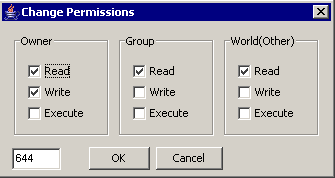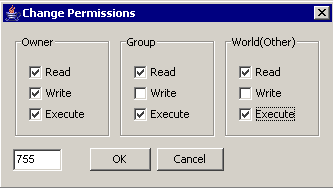
In most cases you will not need to change permissions to work on your Web site, but advanced users sometimes have to change permissions.
Every file on a Web server has to have the proper permissions in order to be displayed and executed on the Web. All read-only files such as html, image, and multimedia files require "World-readable" permissions; all script files require "World-executable" permissions.
For our purposes, we need only know which files require which permissions. However, we should note that, in general, read-only files automatically inherit the proper permission and you shouldn't have to manually modify their permissions.
There are two means of assigning file permissions using a FTP client:
Individually assign read, write, and execute permissions to the three types of permission levels: Owner, Group, and World.
Assign read, write and execute permissions in numeric (octal) form.
For example, permissions for html, image and multimedia files should be:

Where the Owner is granted read and write access; Group is granted read access; World is granted read access. Alternatively, you can assign the numeric equivalent: 644.
The permissions for script files should be:

Where the Owner is granted read, write and execute access; Group is granted read and execute access; World is granted read and execute access. Alternatively, you can assign the numeric equivalent: 755.
![]() To change permissions:
To change permissions:
|
1 |
Select the file you want to open on the server. In this example, the welcome .htm file is selected on the right or remote side of the FTP tool.
|
|
2 |
Right-click on the file to see the menu options. |
|
3 |
Click Change Permissions. |
|
4 |
The Change Permissions window appears. You can change permissions as needed by selecting and deselecting the appropriate checkboxes. There is also a field next to the ok button where you can enter a preset such as "644," if you are familiar with file permissions.
Note: You can also change permissions for folders by right-clicking on the folder. When you are finished, click OK.
|
![]()